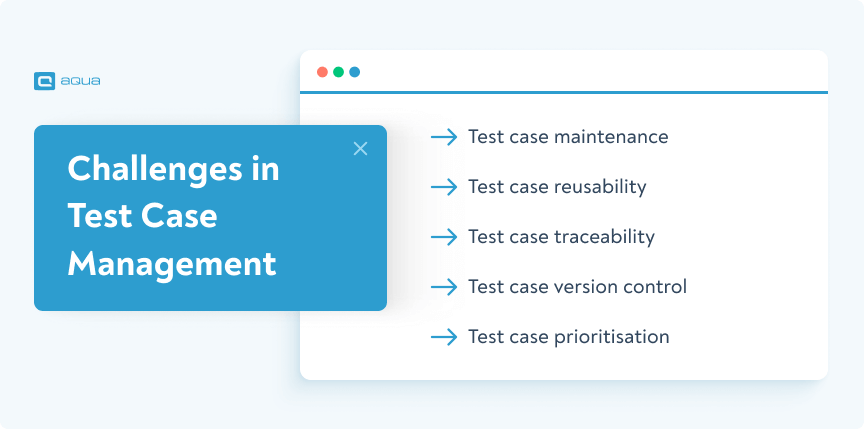But here’s the thing – test case management is no longer just an option; it’s a necessity. In today’s competitive landscape, where user expectations are soaring and time-to-market is critical, you can’t afford to overlook the power of effective test case management.
In this article, we will unveil the secrets of successful test case management, providing you with the knowledge and insights you need to maximise your testing potential and escape the labyrinth of unorganised QA.
What is test case management?
Test case management is a systematic approach to organising, documenting, and tracking test cases and related activities during software testing. It involves planning, designing, executing, and tracking results to ensure a software product’s quality and functionality.
Test case management is a framework that helps QA professionals, especially testers, effectively manage testing. Test management platforms offer a centralised repository to store and manage test cases, suites, data, and results.
Test case management tools offer many features to streamline the process. These tools enable testers to create and organise test cases, assign priorities and dependencies, track progress, and generate reports while facilitating team collaboration.
Who needs test case management?
Test case management is essential for various stakeholders in the software development lifecycle to ensure effective testing, quality assurance, and product delivery. Understanding who needs test case management and why it’s vital will enhance the overall efficiency and success of a project.
- Quality Assurance (QA) Teams: You, as a QA professional, rely on test case management to systematically organise, execute, and track test cases, ensuring comprehensive coverage and identifying any defects early in the development process.
- Developers: By having access to well-documented test cases, developers can understand the coverage and outcomes of tests related to their code, leading to faster debugging and more robust code quality.
- Project Managers: They use test case management to monitor testing progress, manage resources efficiently, and ensure that project timelines are met without compromising on quality.
- Business Analysts: Test case management helps them verify that the software meets business requirements and user needs, ensuring that the delivered product aligns with the initial specifications.
- Product Owners: They benefit from test case management by ensuring the final product aligns with customer expectations and quality standards, ultimately leading to higher customer satisfaction and fewer post-release issues.
By involving all these stakeholders in the test case management process, organizations can achieve a more coordinated and effective approach to software development and delivery.
Test Scenario vs Test Case vs Test Script
Understanding the differences between test scenarios, test cases, and test scripts is crucial for effective test planning and execution. Although used interchangeably, they have major differences and here are the main ones:
- Test Scenario: A high-level description of a functionality or feature to be tested. It outlines what to test but does not go into detailed steps.
- Test Case: A detailed description of how to test a particular functionality or feature. It includes specific inputs, execution steps, and expected outcomes.
- Test Script: An automated sequence of instructions executed by a testing tool to perform a test. It often corresponds to one or more test cases and can be written in various scripting languages.
| Aspect | Test Scenario | Test Case | Test Script |
|---|---|---|---|
| Definition | High-level description of a feature to be tested. | Detailed steps to test a specific functionality. | Automated instructions for testing a feature. |
| Detail Level | High-level, broad coverage. | Detailed, specific steps and outcomes. | Detailed, includes code for execution. |
| Purpose | Identifies what to test. | Describes how to test it. | Automates the testing process. |
| Format | Narrative description. | Structured with steps, inputs, and outputs. | Code or script format. |
| Usage | Used in initial planning stages. | Used during test execution by QA teams. | Used for automated testing by tools. |
| Example | “Verify login functionality.” | “Enter valid username and password, click login, expect home page to load.” | “Script to automate login and verify home page.” |
Components of a test case
When creating test cases, you should include several essential components to ensure their effectiveness and comprehensiveness:
- Test case ID: A unique identifier or number for easy tracking and reference.
- Test case title: A concise and descriptive title summarising the test case objective or goal.
- Test description: A detailed description of the tested functionality or features, outlining the inputs, actions, and expected outcomes.
- Preconditions: All necessary requirements or conditions that must be met before test case execution, including data setup, system configurations, or specific application states.
- Test steps: Clear instructions on executing the test case, including the specific actions and the expected results at each step.
- Test data: The input data you must use during the test case execution, including valid and invalid data sets to validate different scenarios.
- Expected results: The anticipated outcomes of the test case that need to be specific, measurable, and aligned with the test objective.
- Actual results: The actual outcome of the test case execution with the deviations or discrepancies from actual results.
- Pass/Fail status: A clear indication of whether the test case passed or failed.
- Test environment: The specific environment, including hardware, software, OS, or browsers.
- Test Priority/Severity: The priority of the test case based on its impact on the system, and severity refers to the degree of impact a bug would have on the system’s functionality.
- Test case author: The name of the person responsible for creating the case.
“Software is like entropy: It is difficult to grasp, weighs nothing, and obeys the Second Law of Thermodynamics; i.e., it always increases.”
What is the role of test case management?
Test case management is crucial in software testing and quality assurance. Here are some key roles and benefits of effective test case management:
- Effective, centralised management: The test case management system consists of a centralised repository to manage test cases, allowing you to access and track them easily.
- Traceability: Test case management ensures comprehensive test coverage by systematically documenting and managing test cases. This way, test case tracking and the mapping between test cases and requirements to test all functionality become easier. Testing efforts are aligned with the project’s objective and meet scope, which can also be easily demonstrated during regulatory audits.
- Planning and prioritisation: Test case management tools enable you to prioritise test cases based on business priorities, risk assessments, and resource constraints, focusing on critical functionalities and high-risk areas.
- Test execution and tracking: Test case management enables better execution and tracking by providing a platform to record test results, track progress, and monitor the statuses.
- Collaboration and communication: Test case management tools promote better collaboration and communication in the team and create an environment for shared information, feedback, and discussions on test case-related issues. Questions and concerns do not get lost in chats.
- Reporting and metrics: Using management tools allow you to generate relevant performance indicators like test execution reports or defect metrics, enabling you to make data-driven decisions and track the effectiveness of your efforts.
- Test maintenance and reusability: Test case management facilitates test maintenance and reusability, as the cases can be easily updated, modified, or reused as the software evolves. This saves you a lot of time and resources.
Looking to enhance your QA test case management? Look no further than aqua’s testing strategy template. This comprehensive resource covers methodologies, tools, and modern approaches to ensure effective test management. From Agile and DevOps methodologies to industry-leading tools and modern practices like BDD and CI/CD, our template has everything you need for successful QA test management. You can learn about industry-leading tools that streamline test case creation, execution, and reporting, allowing you to track progress and identify areas for improvement.

Use just one source to skyrocket your test management efforts
Everyone does their test cases differently. Don't worry about a specific style and worry more about including necessary info.
Test case management methodologies
There are two commonly used test case management approaches:
- Spreadsheet-based test case management is a common method of using spreadsheets or similar tools to manage test cases. Testers typically use document-based templates or spreadsheets to organise and maintain test cases. They create test case templates in the document outlining the steps and expected results. This approach offers flexibility and ease of use but does not include advanced features like test execution tracking or seamless collaboration. It does not meet modern regulatory requirements most of the time, either.
- Test case management tools provide dedicated platforms or software solutions to streamline your efforts. These tools allow automated test case management and offer features such as test case creation, organisation, version control, execution tracking, defect management, and reporting. Test case management software provides a centralised repository for test cases, facilitates collaboration among team members, and offers robust reporting capabilities.
You can also use such solutions for first-party test automation or seamless integration with third-party solutions. Examples of popular automation management tools include aqua, Zephyr, and qTest.
There are different approaches to test case management, including the following:
- Agile test case management includes methodologies like Scrum or Kanban, focusing on iterative development and frequent software releases. It involves creating and managing test cases that align with user stories or features defined in the product backlog.
In this methodology, you continuously refine and update test cases based on evolving requirements and integrate test execution within the sprint or iteration cycles. This approach emphasises flexibility, adaptability, and collaboration between developers, testers, and stakeholders. - Behaviour-driven development (BDD) is a collaborative approach that aligns business stakeholders, developers, and testers with defining and validating software behaviour. This way, you write test cases in an extra human-friendly format using a domain-specific language (DSL) like Gherkin. These test cases, known as “feature files”, outline desired behaviours and acceptance criteria.
- Continuous Integration/Continuous Delivery (CI/CD) test case management ensures a robust and efficient testing process. Test cases are integrated into the CI/CD pipeline, and automated tests are executed as part of the build and deployment processes. The required effort includes maintaining a suite of automated tests, monitoring test execution results, and incorporating test failures or issues into the CI/CD feedback loop.
- Waterfall test case management: In a Waterfall approach, test case management follows a sequential process where you perform testing at the end of each development phase. Test cases are designed and executed based on the defined requirements and specifications. The emphasis is on comprehensive testing before moving to the next development phase.
How to do test case management?
Test case management is a crucial aspect of software testing that ensures comprehensive coverage, systematic execution, and accurate tracking of test cases. Here’s a comprehensive guide to effective software test case management:
- Define Objectives and Scope
- Identify Goals: Determine the purpose of your testing efforts, such as validating functionality, ensuring performance, or verifying security.
- Scope Definition: Define the scope of your testing by identifying the features and functionalities to be tested.
- Select a Test Case Management Tool
- Tool Evaluation: Choose an agile test case management software that fits your project’s needs. Consider features like ease of use, integration with other tools, reporting capabilities, and cost.
- Popular Tools: Examples include aqua cloud, QTest, etc.
- Create a Test Plan
- Test Plan Document: Develop a comprehensive test plan outlining the testing strategy, objectives, scope, resources, schedule, and deliverables.
- Stakeholder Approval: Get approval from key stakeholders to ensure alignment with project goals.
- Design Test Cases
- Identify Test Scenarios: Outline high-level test scenarios covering all major functionalities.
- Detailed Test Cases: For each scenario, create detailed test cases that include:
- Test Case ID: A unique identifier.
- Description: Brief description of the test case.
- Preconditions: Any setup or prerequisites.
- Test Steps: Detailed steps to execute the test.
- Test Data: Specific data required for the test.
- Expected Results: The anticipated outcome of the test.
- Actual Results: The actual outcome observed during testing.
- Status: Pass/Fail based on the comparison of expected and actual results.
- Organize Test Cases
- Categorise: Group test cases by module, feature, or functionality for better organization.
- Prioritise: Assign priority levels (e.g., high, medium, low) based on the impact on the system and business requirements.
- Traceability: Ensure traceability between requirements, test cases, and defects.
- Execute Test Cases
- Environment Setup: Prepare the test environment to match the production environment as closely as possible.
- Assign Test Cases: Allocate test cases to QA team members based on their expertise and availability.
- Test Execution: Perform the tests according to the predefined steps, record the actual results, and compare them with the expected results.
- Track and Manage Defects
- Log Defects: Record any deviations from the expected results as defects, providing detailed information for reproduction and resolution.
- Prioritise Defects: Classify defects based on severity and impact on the system.
- Track Resolution: Monitor the progress of defect resolution, retest fixed defects, and update their status accordingly.
- Review and Update Test Cases
- Regular Review: Periodically review test cases to ensure they are up-to-date with the latest requirements and system changes.
- Refine Test Cases: Modify or add new test cases based on changes in the application or new insights gained during testing.
- Reporting and Metrics
- Test Reports: Generate test execution reports that provide insights into test coverage, pass/fail rates, defect density, and other key metrics.
- Stakeholder Communication: Share test results and insights with stakeholders to keep them informed about the quality and readiness of the product.
- Continuous Improvement
- Lessons Learned: Conduct post-test reviews to identify lessons learned and areas for improvement.
- Feedback Loop: Use feedback from testing phases to continuously improve test case design, execution processes, and overall test management practices.

Conclusion
Test case management is a critical aspect of the software testing process. While it presents challenges, addressing them with effective strategies and utilising the right tools can greatly enhance the efficiency and effectiveness of test case management. Testers can ensure comprehensive testing coverage and deliver high-quality software by overcoming maintenance, reusability, traceability, version control, and prioritisation challenges.
Looking to streamline your test case management process? Explore aqua cloud, an AI-driven, modern test case management solution. With the aqua testing tool, you can eliminate manual work, accelerate testing cycles, improve collaboration among team members, and simultaneously create test cases from scratch. Take your testing to new heights with aqua cloud and experience the benefits of super-fast and intelligent test case management.
Level up your test case management with a few clicks


















